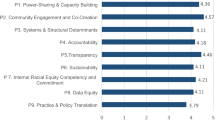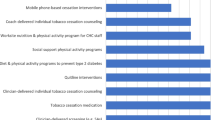Abstract
Achieving health equity requires addressing social determinants of health. Promoting health equity as it relates to cancer control is one of six priorities of the National Comprehensive Cancer Control Program (NCCCP). This article describes recent activities implemented by three NCCCP awardees (North-west Portland Area Indian Health Board, Kansas, Michigan) and the CDC-funded National Behavior Health Network (NBHN), whose aim is to reduce health disparities among those with mental health and/or substance disorders. North-west Portland administered tribal surveys to help better understand tribal cancer-related risk factors, health behaviors, provide baseline data to support their cancer plan, and obtain resources for targeted interventions. Kansas established a health equity workgroup with a vision of addressing health equity through implementation and uptake of activities among all Kansans. Michigan provided trainings in health equity and social justice and developed health equity learning labs. As a result of the successful implementation of the NBHN’s Community of Practice, individuals currently living with mental illness and/or substance disorders have had increased access to tobacco cessation and other cancer support services. These efforts and key opportunities for public health practitioners and their partners to increase engagement in cancer health equity are summarized in this article.
Similar content being viewed by others
References
US Department of Health and Human Services, National Partnership for Action to End Health Disparities. National Stakeholder Strategy for Achieving Health Equity. National Stakeholder Strategy for Achieving Health Equity. https://minorityhealth.hhs.gov/npa/files/Plans/NSS/CompleteNSS.pdf. Accessed 25 Oct 2018
Social Determinants of Health. Healthy People 2020. https://www.healthypeople.gov/2020/topics-objectives/topic/social-determinants-health. Accessed 25 Oct 2018
Hayes N, Rollins R, Weinberg A et al (2005) Cancer-related disparities: weathering the perfect storm through comprehensive cancer control approaches. Cancer Causes Control 16(Suppl 1):41–50
Weinberg AD, Jackson PM, De Courtney CA et al (2010) Progress in addressing disparities through comprehensive cancer control. Cancer Causes Control 21:2015–2021
White MC, Babcock F, Hayes NS et al (2017) The history and use of cancer registry data by public health cancer control programs in the United States. Cancer 123(Suppl 24):4969–4976
Purnell TS, Calhoun EA, Golden SH et al (2016) Achieving health equity: closing the gaps in health care disparities, interventions, and research. Health Aff 35:1410–1415
Consortium of National Networks to Impact Tobacco-Related and Cancer Health Disparities. https://www.cdc.gov/tobacco/about/coop-agreements/national-networks/index.htm. Accessed 24 July 2018
White MC, Espey DK, Swan J, Wiggins CL, Eheman C, Kaur JS (2014) Disparities in cancer mortality and incidence among American Indians and Alaska Natives in the United States. Am J Public Health 104(Suppl 3):377–387. https://doi.org/10.2105/AJPH.2013.301673
Kohler BA, Sherman RL, Howlader N et al (2015) Annual report to the nation on the status of cancer, 1975–2011, featuring incidence of breast cancer subtypes by race/ethnicity, poverty, and state. J Natl Cancer Inst 107(6):djv048. https://doi.org/10.1093/jnci/djv048
Plescia M, Henley SJ, Pate A, Underwood JM, Rhodes K (2014) Lung cancer deaths among American Indians and Alaska Natives, 1990–2009. Am J Public Health 104(Suppl 3):S388–S395. https://doi.org/10.2105/AJPH.2013.301609
Watson M, Benard V, Thomas C, Brayboy A, Paisano R, Becker T (2014) Cervical cancer incidence and mortality among American Indian and Alaska Native women, 1999–2009. Am J Public Health 104(Suppl 3):S415–S422. https://doi.org/10.2105/AJPH.2013.301681
Espey DK, Wu XC, Swan J, Wiggins C, Jim MA, Ward E, Wingo PA, Howe HL, Ries LA, Miller BA, Jemal A, Ahmed F, Cobb N, Kaur JS, Edwards BK (2007) Annual report to the nation on the status of cancer, 1975–2004, featuring cancer in American Indians and Alaska Natives. Cancer 110(10):2119–2152
Wiggins CL, Espey DK, Wingo PA et al (2008) Cancer among American Indians and Alaska Natives in the United States, 1999–2004. Cancer 113(Suppl 5):1142–1152. https://doi.org/10.1002/cncr.23734
Cobb N, Espey D, King J (2014) Health behaviors and risk factors among American Indians and Alaska Natives, 2000–2010. Am J Public Health 104(Suppl 3):481–489. https://doi.org/10.2105/AJPH.2014.301879
Steele CB, Cardinez CJ, Richardson LC, Tom-Orme L, Shaw KM (2008) Surveillance for health behaviors of American Indians and Alaska Natives-findings from the behavioral risk factor surveillance system, 2000–2006. Cancer 113(Suppl 5):1131–1141. https://doi.org/10.1002/cncr.23727
Abed J, Reilley B, Butler MO, Kean T, Wong F, Hohman K (2000) Developing a framework for comprehensive cancer prevention and control in the United States: an initiative of the Centers for Disease Control and Prevention. J Public Health Manag Pract 6(2):67–78
Watanabe-Galloway S, Duran T, Stimpson JP, Smith C (2013) Gaps in survey data on cancer in American Indian and Alaska Native populations: examination of US population surveys, 1960–2010. Prev Chronic Dis 10:E39. https://doi.org/10.5888/pcd10.120258
Centers for Disease Prevention and Control. Behavioral Risk Factor Surveillance System. http://www.cdc.gov/brfss/. Accessed on 25 Oct 2018
Kansas Cancer Partnership (2018) Kansas Cancer Partnership. http://kscancerpartnership.org/
Michigan Cancer Consortium. http://www.michigancancer.org/. Accessed 23 Oct 2018
Michigan Cancer Consortium. Cancer Plan Priorities. https://www.michigancancer.org/CancerPlan/MCCPriorities.html. Accessed on 25 Oct 2018
Wenger E, McDermott R, Snyder W (2002) Cultivating communities of practice: a guide to managing knowledge. Harvard Business Press, Boston
Michigan Public Health Institute (2018) NBHN master class community of practice wrap up evaluation. National Council for Behavioral Health, Washington, DC
Penman-Aguilar A, Talih M, Huang D et al (2016) Measurement of health disparities, health inequities, and social determinants of health to support the advancement of health equity. J Public Health Manag Pract 22(1 Supp):S33–S42
Health People, Health Disparities Data. (https://www.healthypeople.gov/2020/data-search/health-disparities-data. Accessed 25 Oct 2018
The Community Guide. https://www.thecommunityguide.org/resources/what-works-health-equity. Accessed 25 Oct 2018
National Institutes of Health. State cancer profiles. Accessed 16 Aug 2018 https://statecancerprofiles.cancer.gov/
National Institute on Minority Health and Health Disparities. HDPulse. https://hdpulse.nimhd.nih.gov/index.html. Accessed 23 Oct 2018
Andermann A, Pang T, Newton JN, Davis A, Panisset U (2016) Evidence for health I: producing evidence for improving health and reducing inequities. Health Res Policy Syst 14(1):18
Liburd LC, Ehlinger E, Liao Y, Lichtveld M (2016) Strengthening the science and practice of health equity in public health. J Public Health Manag Pract 22:S1–S4
Major A, Stewart SL (2009) Celebrating 10 Years of the National Comprehensive Cancer Control Program, 1998 to 2008. Prev Chronic Dis 6(4):A133
Acknowledgments
The authors would like to acknowledge the National Behavior Health Network (NBHN) for providing relevant data for the development of this manuscript. The authors would like to acknowledge Angela McFall, Julie Sergeant, Jamila Fonseka and Kristi Fultz-Butts for providing insight into the partnerships to reduce health disparities.
Author information
Authors and Affiliations
Corresponding author
Ethics declarations
Conflict of interest
The authors declare that they have no conflict of interest.
Additional information
Disclaimer
The findings and conclusions in this report are those of the authors and do not necessarily represent the official position of the Centers for Disease Control and Prevention. Use of trade names is for identification only and does not imply endorsement by the U.S. Department of Health and Human Services.
Rights and permissions
About this article
Cite this article
Momin, B., Wanliss, E., Davis, L. et al. Advancing health equity through the National Comprehensive Cancer Control Program. Cancer Causes Control 29, 1231–1237 (2018). https://doi.org/10.1007/s10552-018-1111-3
Received:
Accepted:
Published:
Issue Date:
DOI: https://doi.org/10.1007/s10552-018-1111-3




